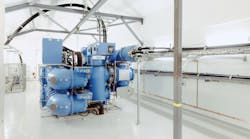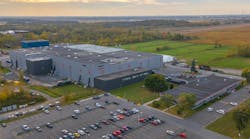Did you know that roughly 80% of all SF6 (sulfur hexafluoride) gas produced worldwide is used by the electric power industry? That headline caught my attention recently and it was followed by another one equally surprising. The largest source of emission (i.e., leaks) of SF6 comes from the power industry using it as an electrical insulator in high-voltage equipment. Tying these facts together helps explain why there is a growing movement to remove SF6 from the electrical grid.
The message has been getting across and a great deal of research and development (R&D) has produced viable alternatives for SF6 in switchgear and other devices. It has taken time, but there are now environmentally friendly replacements for SF6 available to the industry. Granted SF6 gas has been a mainstay in electric power grid when it comes to an insulating medium, but that is changing. Slowly the power delivery industry is moving away from this environmentally harmful insulation medium.
SF6 is a synthetic gas with a fantastic electrical insulating quality. It has been used in switchgear, instrument transformers, and other electrical devices for many decades. It also has tremendous current interruption capabilities, and it displays incredible arc breaking properties. There is, however, more to the story.
Adding to Global Warming
According to the EPA (US Environmental Protection Agency) SF6 has been identified as the most harmful and longest lasting greenhouse gas produced by human activity. It’s an F-gas. F-gases are synthetic fluorinated gases that have proven to be harmful to the environment. There are many greenhouse gases. How does all of this relate to the power grid’s use of SF6?
EPA’s report addresses that, explaining that there are several properties giving SF6 such a high profile when it comes to damaging the environment. The emissions have a 3,200 year life span, which makes it extremely long-lived. In other words, any SF6 emissions accumulation does not degrade. Another of SF6’s worrisome properties is its global warming potential (GWP).
What is a GWP rating? It’s an indexing scale based on a number of factors using carbon dioxide (CO2) as the reference greenhouse gas. Basically the GWP for a greenhouse gas is the amount of heat absorbed by 1 ton of emissions from that gas in the atmosphere compared to 1 ton of the reference gas (i.e., CO2) during a specific time frame.
The period of time being used for GWP calculation is 100 years. 1 ton of CO2 has a GWP value of 1 (the reference point), and 1 ton of SF6 has a GWP value of 23,500. With that GWP rating, SF6 is 23,500 times more potent than CO2 when it comes to SF6’s effect on the environment. Or 1 ton of SF6 does as much damage to the atmosphere as 23,500 tons of CO2.
Alternatives
SF6 gas is very efficient when it comes to trapping infrared radiation. A relatively small amount of it can have a significant impact on global climate change that lasts for centuries. Adding all of these data points together explains the reason for the headlines that started this discussion, and the growing support for banning F-gases. But it’s not all gloom and doom! There are several SF6 alternatives available. These alternatives include a purified air compound, non-synthetic mixtures, and gases from the PFAS (per- and polyfluoroalkyl substances) family.
Each of these alternatives have economic and/or environmental considerations, and like all technological advancements users should understand the pros and cons involved with each of them. There are some environmental concerns with the PFAS gases, which are being studied by several regulatory bodies, but that may be a moot point soon. One of the major suppliers of these gases announced last year they were discontinuing their production of PFAS in 2025.
Manufactures like GE, Hitachi Energy, Mitsubishi, Schneider Electric Siemens Energy, and Toshiba to name a few have taken advantage of the R&D and are now offering non-SF6 switchgear. It’s encouraging that there are a number of compounds that are viable as replacement alternatives for SF6 gas, but it’s somewhat complicated.
Digging Deeper
With that in mind, “Charging Ahead” spoke with Dr Mark Kuschel, Head of International Standardization for Grid Technologies at Siemens Energy to get a better understanding of the global picture. Dr Kuschel began the discussion saying, “SF6 is not the future, it’s the past! SF6 has been the standard insulation solution used in switchgear worldwide since the 1960s, but this has to change. As the global consumption of electricity increases, so does the demand for switchgear. Those switchgear must have an environmentally friendly insulation medium. Now is exactly the right time for the electric power industry to move to F-gas-free insulation technology.”
Kuschel explained, “In March, 2023, the European Parliament’s committee on Environment, Public Health, and Food Safety (ENVI) voted to accelerate the complete phase-out of SF6 and the other fluorinated gases. For electrical apparatus, it’s a staged approach. The ban would take effect on all voltage levels, in high-voltage switchgears with 145 kV (kilo volt) and below and a current capacity of 50 kA (kilo ampere) and below by January 1, 2028. Voltage levels above 145 kV and above 50 kA by January 1, 2031, but this is not an unexpected event.”
“Siemens Energy started working on an F-gas-free alternative over ten years ago, and has developed a technology using purified air that we call clean air. Clean air is a mixture of 80% N2 (nitrogen) and 20% O2 (oxygen), and has a GWP of zero. Worldwide, various manufacturers are using the clean air approach and alternative insulations based on mixtures of CO2 and O2. These have been referred to as natural origin gases with a GWP less than one.” Dr. Kuschel said.
He continued, “When the industry moved from oil to SF6 there was some pushback because it was a new process. There wasn’t any experience with the new technology, and it took time to make sure SF6 technology was dependable. Now utilities have to reach the same point of acceptance for clean air technology. To date, Siemens Energy has delivered more than 3,000 units from its F-gas-free Blue Portfolio with some being in service for over five years. The field experience has been positive, the technology has proven to be dependable. Siemens Energy is committed to being F-gas-free and aims to sell only F-gas-free high-voltage switching technology worldwide starting in 2030 at the latest.”
Give & Take
On the global regulatory front, there is a mixed bag of guidelines, rules, and regulations. In the US, the EPA has monitoring and emissions requirements for F-gases, but bans are being proposed by individual states. The most ambitious comes from the California Air Resource Board (CARB). Last year the CARB’s regulations took effect for the reduction of SF6 in gas insulated equipment.
These phase-out dates are much like those from ENVI. They are based on voltage levels and current capacities with the low voltages coming first and working up to the higher levels. The phase-out limits start becoming effective January 1, 2025 and will be complete by 2033.
With the ENVI ban on F-gases in switchgear, the Norwegian distribution system operator Fagne announced they have signed an agreement with Siemens Energy to supply climate-neutral Blue portfolio switchgear. The switchgear will use synthetic air (Clean Air) in conjunction with vacuum-switching technology at their substations in Sunnhordland and Haugalandet, Norway.
Last year, European transmission system operator TenneT placed an order with Hitachi Energy for three bays of Hitachi Energy’s SF6-free EconiQ 420 kV gas-insulated switchgear (GIS). TenneT said the GIS uses technology that eliminates SF6. The project is expected to be completed in 2026.
TEPCO Power Grid in Japan awarded a contract to Toshiba Energy Systems & Solution Corp. for a 72 kV GIS at Fuchu substation. The GIS uses an insulating medium of nitrogen and oxygen (synthetic air), which is completely SF6 free. The project is expected to be completed in 2023.
Entergy Mississippi recently installed a 123 kV Siemens Energy Blue circuit breaker at one of its substations in Vicksburg as part of its effort to achieve net-zero carbon emissions by 2050. The Blue circuit breaker is a replacement for a high-voltage oil circuit breaker. The Blue circuit breaker uses clean air in combination with a vacuum interrupter to provide an SF6-free switchgear.
Those are only a few of the examples available illustrating how utilities and grid operators are moving from SF6 insulated equipment to F-gas-free switchgears, but there is another issue. With 80% of the world’s SF6 gas in the power grid’s equipment, it’s important to curtail new SF6 additions. Authorities say it’s equally important to develop the technology to stop leaks and prevent emissions of SF6 from existing equipment. This is another important step in addressing the SF6 issues facing the power delivery industry. It’s going to be challenging, but it’s manageable. That’s what makes following technological trends so fascinating!


